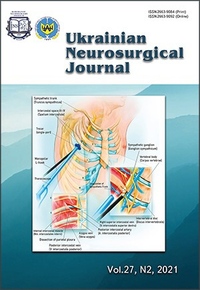Correlation analysis of electroneuromyographic, functional-anatomical and morphometric indicators of regeneration of the injured sciatic nerve
DOI:
https://doi.org/10.25305/unj.227615Keywords:
peripheral nerve injury, neurorrhaphy, adhesive joint, Duraseal, Tisseel, regenerationAbstract
Objective. To study the electrophysiological, functional-anatomical and morphometric indicators of the sciatic nerve regeneration after complete transection and connection of the nerve stumps with epineural sutures and adhesives.
Materials and methods. The experiments were carried out on white outbred male rats. The efficiency of sciatic nerve regeneration was investigated with the standard 4-6 epineural sutures and the use of polyethylene glycol hydrogel Duraseal or Tisseel fibrin glue with 2 fixation sutures. On the 14th, 30th and 60th days after the complete transection of the sciatic nerve and subsequent connection of the nerve stumps with epineural sutures, hydrogel or fibrin glue, limb function was assessed using SFI test and ENMG. The distal segment of the nerve was sampled for electron microscopic and morphometric studies. The density of the regenerated myelinated nerve fibers was studied and a correlation analysis was performed with the results of SFI test and ENMG.
Results. The use of adhesives provides a similar result of connecting the transected sciatic nerve, as in standard neurorrhaphy, and regeneration of myelinated nerve fibers in the distal nerve. The regeneration density of myelinated nerve fibers significantly increased on the 30 th and 60th days in the groups in which Duraseal hydrogel and Tisseel fibrin glue were used, without a statistically significant difference in ENMG parameters (M-response amplitude, nerve conduction velocity, latency period) and the result of SFI test. The amplitude of M-response on the 30th day was statistically significantly lower after the connection of nerve stumps with Tisseel fibrin glue in comparison with the Duraseal hydrogel, whereas on the 60th day there was no difference according to the results of electrophysiological studies.
Conclusions. The efficiency of sciatic nerve regeneration after the combined connection exceeds the standard technique, and the results of pathophysiological assessments are more often correlated with morphometry data on the 30th day.
References
1. Gordon T, Eva P, Borschel GH. Delayed peripheral nerve repair: methods, including surgical 'cross-bridging' to promote nerve regeneration. Neural Regen Res. 2015 Oct;10(10):1540-4. [CrossRef] Erratum in: Neural Regen Res. 2021 Feb;16(2):349. [PubMed] [PubMed Central]
2. Caillaud M, Richard L, Vallat JM, Desmoulière A, Billet F. Peripheral nerve regeneration and intraneural revascularization. Neural Regen Res. 2019 Jan;14(1):24-33. [CrossRef] [PubMed] [PubMed Central]
3. Tsymbaliuk VI, Medvediev VV, Ivanchov PV, Molotkovets VY, Chaikovsky YB, Korsak AV. Electrical welding technology in restoring the integrity of the injured peripheral nerve: review of literature and own experimental research. Ukr Neurosurg J. 2020;26(2):24-33. [CrossRef]
4. Martins RS, Siqueira MG, da Silva CF, Plese JP. Correlation between parameters of electrophysiological, histomorphometric and sciatic functional index evaluations after rat sciatic nerve repair. Arq Neuropsiquiatr. 2006 Sep;64(3B):750-6. [CrossRef] [PubMed]
5. Gasparini ALP, Barbieri CH, Mazzer N. Correlation between different methods of gait functional evaluation in rats with ischiatic nerve crushing injuries. Acta Ortop Bras. 2007; 15(5): 285-9. [CrossRef]
6. Wang T, Ito A, Aoyama T, Nakahara R, Nakahata A, Ji X, Zhang J, Kawai H, Kuroki H. Functional evaluation outcomes correlate with histomorphometric changes in the rat sciatic nerve crush injury model: A comparison between sciatic functional index and kinematic analysis. PLoS One. 2018 Dec 12;13(12):e0208985. [CrossRef] [PubMed] [PubMed Central]
7. Kolomiytsev AK, Chaykovskiy YUB, Tereshchenko TL. Bystryy metod impregnatsii azotnokislym serebrom elementov perifericheskoy nervnoy sistemy, prigodnyy dlya tselloidinovykh i parafinovykh srezov. Arkhiv anatomii, gistologii i embriologii. 1981;81(8):93-6.
8. Hayat M.A. Principles and techniques of electron microscopy: biological applications. Cambridge University Press, 2000.
9. Sobolev VI, Trush VV, Litvyak KA, Morozova IN. Frequency Dependence of Parameters of the М Response of the Rat M. Tibialis in the Norm and in Experimental Hyperthyroidism and Hypercorticoidism. Neurophysiology. 2015 June; 47(1): 53-60. [CrossRef]
10. Molotkovets VY, Medvediev VV, Korsak AV, Chaikovsky YuB, Marynsky GS, Tsymbaliuk VI. Restoration of the Integrity of a Transected Peripheral Nerve with the Use of an Electric Welding Technology. Neurophysiology, 2020 June; 52(1): 31-42. [CrossRef]
11. Lin YF, Xie Z, Zhou J, Chen HH, Shao WW, Lin HD. Effect of exogenous spastin combined with polyethylene glycol on sciatic nerve injury. Neural Regen Res. 2019 Jul;14(7):1271-1279. [CrossRef] [PubMed] [PubMed Central]
12. Lin KL, Yang DY, Chu IM, Cheng FC, Chen CJ, Ho SP, Pan HC. DuraSeal as a ligature in the anastomosis of rat sciatic nerve gap injury. J Surg Res. 2010 Jun 1;161(1):101-10. [CrossRef] [PubMed]
13. Monte-Raso VV, Barbieri CH, Mazzer N, Yamasita AC, Barbieri G. Is the Sciatic Functional Index always reliable and reproducible? J Neurosci Methods. 2008 May 30;170(2):255-61. [CrossRef] [PubMed]
Downloads
Published
How to Cite
Issue
Section
License
Copyright (c) 2021 O. O. Goncharuk, S. I. Savosko, T. I. Petriv, M. M. Tatarchuk, V. V. Medvediev, V. I. Tsymbaliuk

This work is licensed under a Creative Commons Attribution 4.0 International License.
Ukrainian Neurosurgical Journal abides by the CREATIVE COMMONS copyright rights and permissions for open access journals.
Authors, who are published in this Journal, agree to the following conditions:
1. The authors reserve the right to authorship of the work and pass the first publication right of this work to the Journal under the terms of Creative Commons Attribution License, which allows others to freely distribute the published research with the obligatory reference to the authors of the original work and the first publication of the work in this Journal.
2. The authors have the right to conclude separate supplement agreements that relate to non-exclusive work distribution in the form of which it has been published by the Journal (for example, to upload the work to the online storage of the Journal or publish it as part of a monograph), provided that the reference to the first publication of the work in this Journal is included.









